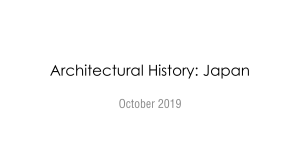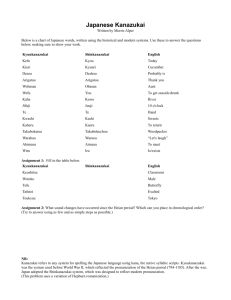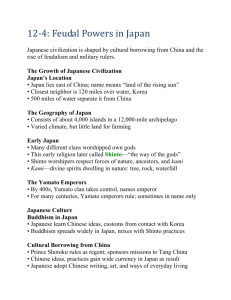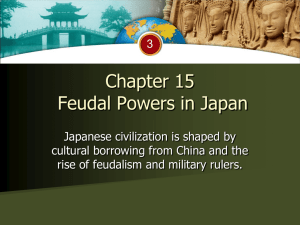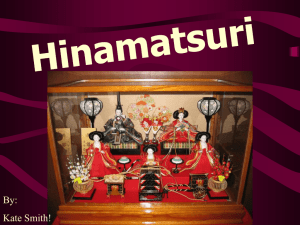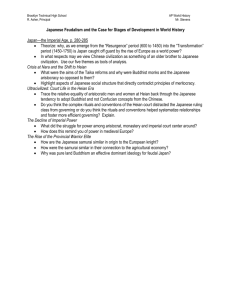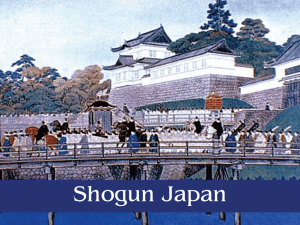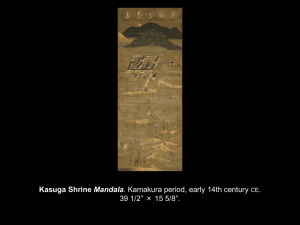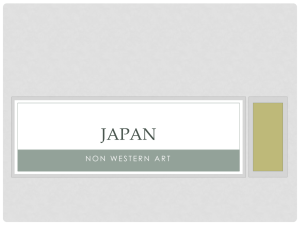Japan
advertisement
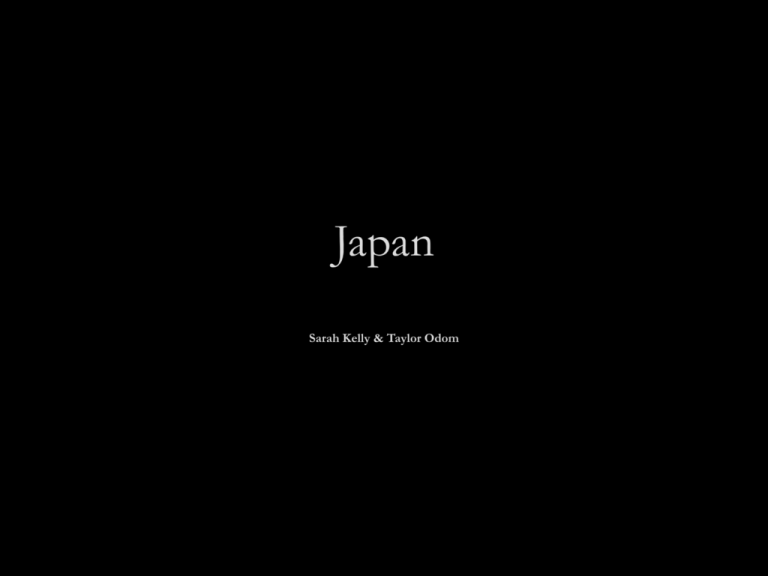
Japan Sarah Kelly & Taylor Odom Jomon and Yayoi Cultures c. 9000-200 BCE and 200 BCE 300 AD • produced simple, undecorated food vessels made of red clay • this is the very beginning of the Japanese culture • used colored slip to create animals and abstract patterns Eventually, the Yayoi took over the Jomon culture and introduced clay sculptures called haniwa, which resided around burial mounds. They later began to produce bronze cast objects (This technique was most likely imported From China) Cultural influences from Korea and China began to be noticed after the introduction of Buddhism, yet the Japanese never actually copied other cultures, only incorporated them into their existing art. Asuka Period 552 AD- 645 AD Asuka became the capital from 538 to 645 (hence the name for this art period) During this period many Buddhist missionaries and artists were welcomed into society. Confucian ideals became widespread. Shinto or “the way of the gods” (an ancient for or nature worship) was still contributing to the Japanese culture, which later began to incorporate the worship of ancestors. A noted architectural piece is Great Dibutsu which stands over 70 feet high. It resides in the Horyu-ji temple which contains the oldest wooden structures in the world. (they also display another cultural infiltration from the Chinese in regards to the reproduction of the Tang dynasty’s style (in regards to a calm and graceful atmosphere with exposed beams) Nara Period 645 AD – 794 AD Guess what? The capital moved again…to Nara. A new era is upon us! Also, once again, the Chinese are still influencing Japan…The court in Japan became very enthusiastic about art and began to sponsor elaborate production and collection of art (especially from China (again) and Persia). Buddhism was firmly integrated into the Japanese culture during this period. This was mostly an uneventful period, noted mainly for its temples and monasteries. Heian Period 794 AD – 1185 AD …so now the capital is Heian (modern day Kyoto). This is the golden age of Japanese art! Since the Japanese broke off ties with China, the Japanese were finally able to create art of their own without any outside cultural influences (hence the golden age). Yamato-e painting evolved: long, decorative scrolls with long narratives expressing their sentiments and nationalistic feelings. Buddhism split into different factions Two noted sects are the Shingon who stressed the adoration of images and figures of gods with many heads…The other is the Amida who stressed peace and spiritual serenity. They constructed wooden buildings with subtle proportions and placed them in natural settings, most commonly near water. These buildings symbolized the harmony that humanity must attain with nature. Kamakura Period 1185 AD- 1392 AD The Heian government fell to a militant invasion and the capital moved to Kamakura. They cast a huge bronze sculpture of Buddha. Now the fashion and tastes of the new capital were different than those of Kyoto’s cultural heritage. Kamakura art became more realistic than past Heian art. Zen Buddhism became popular, promoting spiritual exercises and simple lifestyles. Paintings began to stress portraiture, battle scenes and everyday life. A drastic contrast to ancient Japanese art occurred when artists began depicting torments in hell, illness and suffering. Cha-no-yu, a new tea ceremony was also inspired by Zen Buddhism. It was first established in Seto, and inspired by the Chinese Song dynasty. Muromachi and Momoyama Periods 1334 AD -1573 AD and 1573 AD- 1615 AD Kyoto was re-established as the capital, thus calling in the Muromachi era. Art began to be patronized by the warrior class. To contrast with the violent atmosphere, tranquil gardens and peaceful arrangements of nature and architectural elements. Noh (dramas), cha-no-yu (tea ceremony) and ikebana (flower arranging) became popular peaceful activities. Personal artwork was displayed in an alcove called tokonoma. Paintings began to be influenced once again by the Chinese with sumi-e (a Chinese ink style). This style was used mostly by a family of painters called Kano, and was later translated into the Momoyama era, where large castles and embellished rooms became popular. Edo Period 1615 AD – 1868 AD This period is one of complete isolation from the outside world due to political turmoil with other countries. European influences and religion were banned, and the capital was moved…again…to Edo (modern day Tokyo). In the Meiji Restoration, Japan was once again opened to the outside world. The Edo period is characterized by its unique style of genre painting, known as ukiyo-e (“the art of the floating world”), popular among the middle class. Ukiyo-e featured colorful images and kabuki (Japanese theatre). Prints were being mass produced. This production marks the transition from ancient art to the modern era. Modern Period 1868 AD - present The Jesuits came in and introduced the first NonJapanese painting techniques (such as oil). A new Japanese pottery production occurred, where they used Kutani and Imari porcelain, which consisted of bright and bold colors. Contemporary artists continue to stick to the simplicity and elegance of the Japanese culture. Imari Kutani Review • • • • • • • • • • Describe haniwa sculptures (slide 2) What are some of the beliefs of the Shinto religion? (slide 3) What are the oldest wooden structures in the world? (slide 3) Where is the great Dibutsu (Buddha)? How tall is it? (slide 3) What modern cities did the ancient cities of Heian and Edo become? (slides 5 & 8) What is yamato-e painting? What type of surface do they use? (slide 5) How was Kamakura art different from Heian art? The subjects that Kamakura art depicted? (slide 6) Vocab: Cha-no-yu (slide 6), noh, ikebana, tokonoma (slide 7) Where were the cha-no-yu ceramics first produced? Which Chinese dynasty influenced them? (slide 6) What style of painting is used by the Kano in the rooms of the Nijo Castle in Kyoto? (slide 7)
